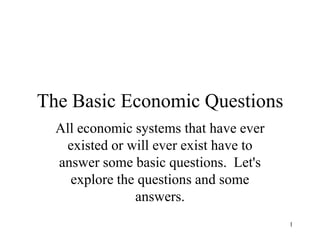
Basic Economic Questions
- 1. 1 The Basic Economic Questions All economic systems that have ever existed or will ever exist have to answer some basic questions. Let's explore the questions and some answers.
- 2. 2 The 3 Questions 1 - What goods and services will be produced? 2 - How will the goods and services be produced? 3 – Who will get the goods and services?
- 3. 3 Throughout history different countries have used different organizing methods to answer the basic economic questions. The command system (socialism or communism) is not as prevalent today as in the past. We will focus on the market system. Some of the main characteristics of a market system are Private property Freedom of enterprise and choice Self-interest Competition markets and prices Technology and capital Specialization of resources Use of money Active, but limited, government
- 4. 4 1) What will be produced? The answer to the first question is that we let the supply and demand of the market determine what and how much to produce. Goods that consumers are both willing and able to buy, and producers are willing and able to make, get made in the amount that both working together see fit. You may be willing and able to go to the moon, but no supplier is willing and able to make that available at this time (although it seems we are getting closer). But just think about all the items that are available in the markets we have today. Note consumers “vote” for goods to be made with their dollars and the goods are likely to be made if firms can make profit.
- 5. 5 2) How? The answer to the second question is producers will use the least cost combination of inputs to produce a given level of output. The reason for this is twofold. First, by using the least cost methods more profit will be earned by the producer. Producers certainly like to make profit. But, the second reason is that if a producer does not use least cost methods of production, when other producers do, the high cost producer may not be able to compete with the other low cost producers and will eventually go out of business.
- 6. 6 Resource use Say there are three ways of making a good from a technical point of view. Here we list the number of units of each resource needed to make a good: Resource technique 1 technique 2 technique 3 Land 4 2 1 Labor 1 3 4 Capital 1 1 2 Entrepreneurial 1 1 1 ability
- 7. 7 Next I show what each resource costs per unit and we can then see how much it costs to make the units under each technique. For now, let’s just say we look to the market to find what it costs to get each unit of each resource. Here technique 2 would be used! Resource technique 1 technique 2 technique 3 Land $2 4 ($8) 2 ($4) 1 ($2) Labor $1 1 ($1) 3 ($3) 4 ($4) Capital $3 1 ($3) 1 ($3) 2 ($6) Entrepreneurial $3 1 ($3) 1 ($3) 1 ($3) ability Total Cost $15 $13 $15 Resource use
- 8. 8 3) For Whom? The answer to the third question is those who are willing and able to pay for the items made. We become able to pay by giving up something that is valuable to us - labor or other assets.
